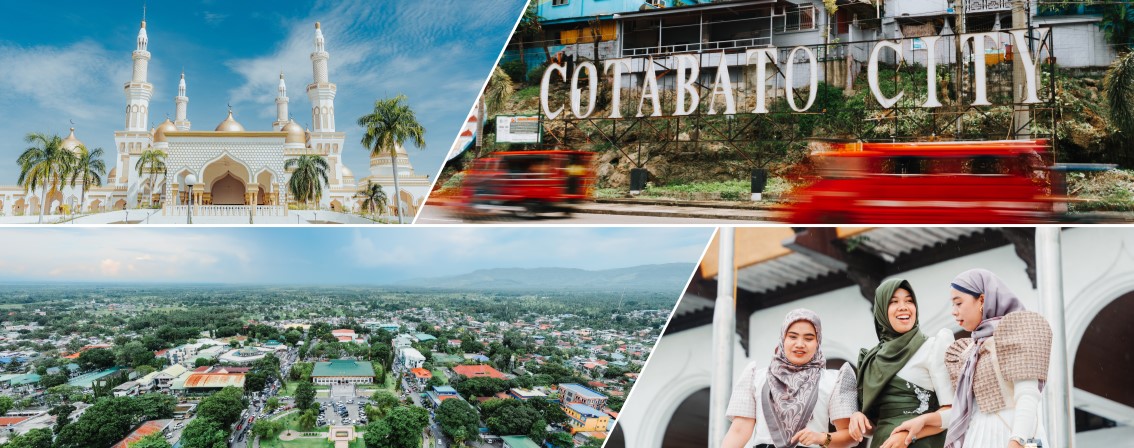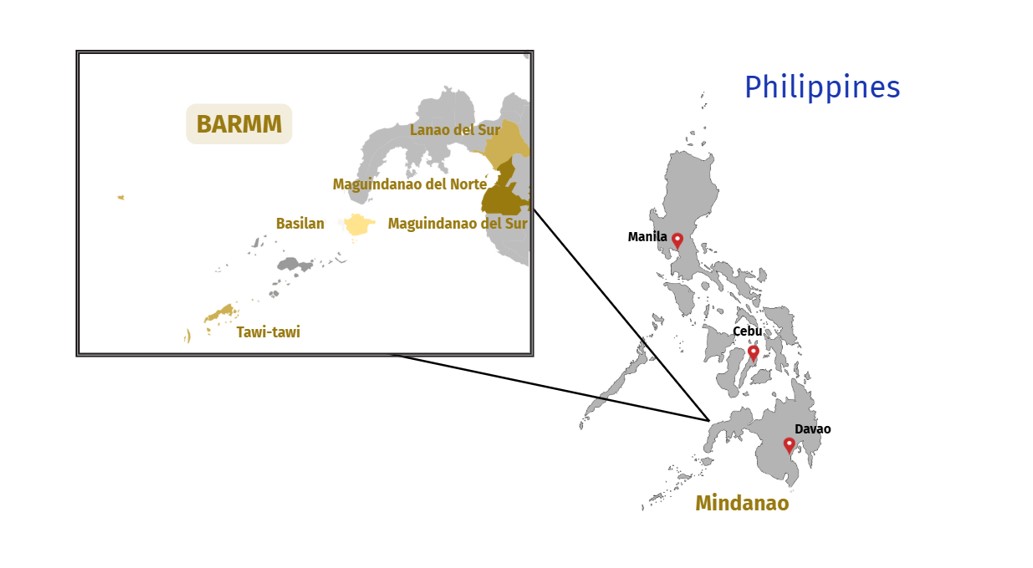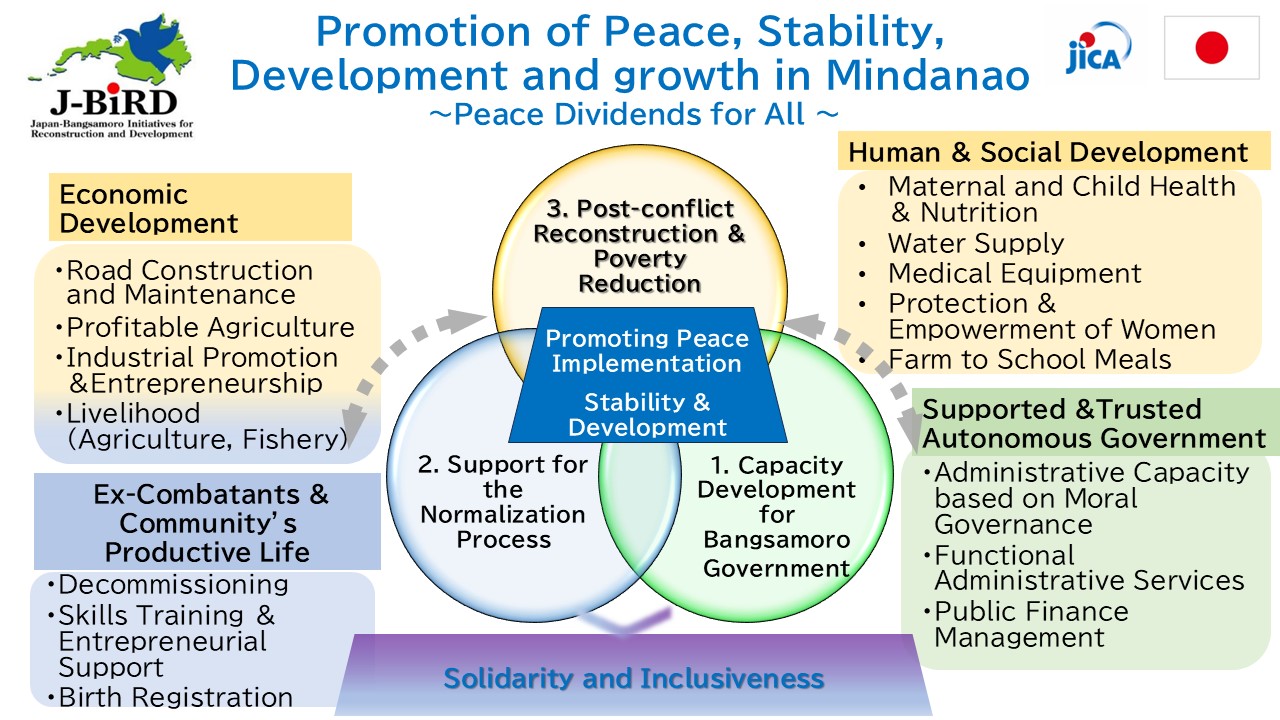Towards the Dividend of Peace and a Brighter Future for All

After half a century of armed conflict, peace is achieved through constant dialogue between all concerned parties. It has also taken the steady cooperation and activities of many Japanese stakeholders, including JICA, to get there.
Mindanao, located in the southern part of the Philippines, is a region centered on Mindanao Island, the second-largest island in the country, and is home to more than 27 million people (PSA, 2024), approximately 24% of the nation's population. With its fertile soil and relatively few damages from natural disasters like typhoons, it is known as the “Land of Promise” and possesses high economic potential.
With the signing and implementation of the
Comprehensive
Agreement on the Bangsamoro
(CAB) in 2014 between the Philippine government and the Moro Islamic Liberation Front (MILF), Mindanao is embarking on a path towards lasting peace and development. Under the commitment of the Japanese government, JICA has been implementing a wide range of cooperation activities to support the peace process and sustainable development in Mindanao.
This special feature highlights the journey and achievements of JICA's cooperation in the BARMM, deeply rooted in the local communities and their daily lives. It also shares our vision for the future.

Struggle for Peace in Mindanao
Islam arrived in Mindanao around the 13th century, and under its influence, various kingdoms led by sultans emerged. The Sultanate of Sulu and the Sultanate of Maguindanao, in particular, prospered through trade and strongly resisted repeated colonial invasions by Spain. However, under the United States’ rule in the Philippines, a settlement policy initiated in 1912 encouraged many Christian settlers to move to Mindanao. This led to escalating tensions between Muslims and Christians. Even after the Philippines gained its independence after World War II, the Philippine government continued the settlement policy, legally expropriating the ancestral lands of indigenous people and Muslims in Mindanao and providing land to settlers for free.
Amidst these rising tensions, the Jabidah Massacre in 1968—the killing of Muslim soldiers by the Philippine National Army—sparked the creation of the Moro National Liberation Front (MNLF) in 1971. This movement was led by Nur Misuari, a university lecturer from Sulu island province, and religious scholar Hashim Salamat. They began an armed struggle for the independence of the Bangsamoro people. In 1984, the Moro Islamic Liberation Front (MILF) splintered off, led by Hashim Salamat. Although the MNLF and MILF pursued different paths, they both fought based on their respective principles and beliefs, seeking ancestral land, self-determination, and justice for the Bangsamoro people.
After years of struggle, the MNLF signed the
Final Peace Agreement
in 1996, and the MILF signed the
Comprehensive Agreement on the Bangsamoro
(CAB) in 2014, respectively, with the Philippine government. The CAB clearly stipulates the establishment of the “Bangsamoro Government” with a high degree of autonomy. Following this, the
Bangsamoro Organic Law
(BOL) was enacted in 2018. In 2019, a plebiscite determined the territory of the Bangsamoro Autonomous Region in Muslim Mindanao (BARMM) and led to the establishment of the Bangsamoro Transition Authority (BTA) in February, as stipulated in CAB and BOL..
The transition process is currently advancing the smooth dialogue between the Philippine government and the BTA towards the implementation of the first Bangsamoro Parliamentary election in BARMM this October 2025, and the subsequent establishment of the elected Bangsamoro Government. Unfortunately, the scheduled BARMM election was postponed twice due to the COVID-19 pandemic and other factors, such as the exclusion of Sulu from BARMM.
JICA's Cooperation Policy for Mindanao
JICA has consistently supported the peace process in Mindanao through development assistance since the 1990s, even before the peace agreement was reached. In 2006, a commemorative year marking the 50th anniversary of diplomatic normalization between Japan and the Philippines, the Japanese government implemented the
Japan-Bangsamoro Initiatives for Reconstruction and Development
(J-BIRD). Under the framework of J-BIRD, JICA and the Japanese government fully embarked on peacebuilding cooperation through development projects, utilizing all available schemes, including ODA grants and loans, technical cooperation, and the dispatch of Japanese experts to be part of to the International Monitoring Team (IMT).
Currently, JICA's cooperation policy is built upon the three pillars: “Capacity Development for Bangsamoro Government,” “Support for the Normalization Process” (*), and “Post-conflict Reconstruction and Poverty Reduction.” JICA is working with the Japanese government and other international donors to bring dividends of peace and bright prospects for the future to all people in Mindanao.

- (*) “Normalization Process” in the peace process in Mindanao:
The Comprehensive Agreement on the Bangsamoro (CAB), signed in 2014, outlines the peace implementation process through two main tracks: the “Normalization Track” and the “Political/Legislative Track.” Under the Normalization Track, the peace implementation process — referred to as the “Normalization Process” — includes three key components: (1) security, (2) socio-economic development, and (3) transitional justice. The largest component is the decommissioning of combatants, which will be followed by the issuance of government-issued identification cards and the provision of 100,000 Philippine Pesos in cash assistance as part of a socioeconomic development program. The “Political Track” was concreted by the BOL enacted in 2018, which established BARMM and its interim government, the BTA. Under this track, the BTA Parliament is advancing the enactment of high-priority bills, aiming to establish a political system for the establishment of the Bangsamoro Government.




scroll